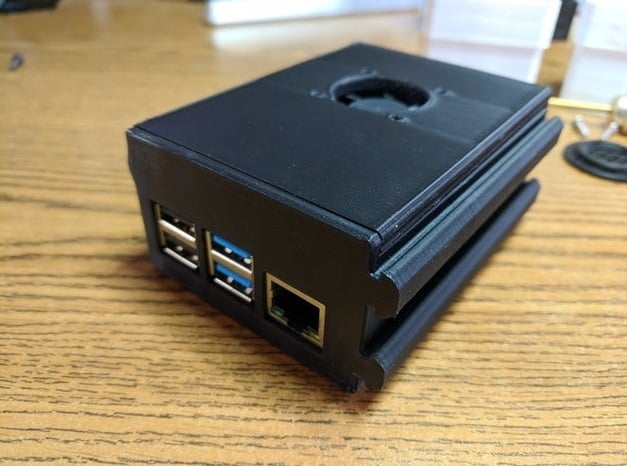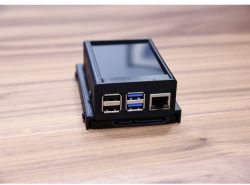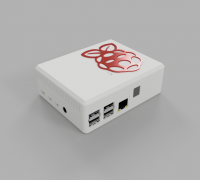Pi 4 Case Stl
The Flirc Raspberry Pi 4 case is another sleek looking aluminum cover with two black soft-touch shell covers. It has a built-in heatsink and comes with a thermal pad. It does not feature a fan, but the manufacturer ensures that the heat sink provides sufficient cooling during CPU stress tests. Flirc Raspberry Pi 4 Case Commissions Earned. Raspberry pi 4 case STL Files for 3D Printers STLBase is a Search Engine for 3D printable Models and STL Files. Click on images to download raspberry pi 4 case STL files for your 3D Printer. Stackable, tool free cases for HifiBerry boards with Raspberry Pi 3 and Raspberry Pi 4 boards with additional rackmount Creator: Christian Huchler Download the.
Flirc Raspberry Pi 4 Case
Newly designed for the Raspberry Pi 4
- $15.95
What is the Flirc Raspberry Pi Case?
The perfect home for your new Raspberry Pi 4. We will ensure our case is adjusted to fit the latest Raspberry Pi specifications. Our case is made of a beautiful aluminum core heat sink that is sandwiched between two black, soft touch shells that feel amazing in your hands. But once it's out of your hands, it blends in with your entertainment system.
WHATS NEW?
This is the first affordable Raspberry Pi case made out of aluminum. We wanted to ensure we didn’t sacrifice form over function, so we used the aluminum housing of the case to provide a built in heat sink. Supplied with the case is a thermal pad and 4 screws for the simplest Raspberry Pi case assembly on the market. It only takes seconds to drop your Raspberry Pi into it’s amazing new home and show it off on your counter top. .

There's more...
We included rubber feet to raise the enclosure so it just hovers underneath your television. In addition to the built in heat sink, small ventilation slots on the bottom help keep the Raspberry Pi cool. GPIO pins are accessible through the slot on the bottom of the case and there is no need for disassembly to get to the SD card. We know you will love the attention to detail we put in throughout the case.
FAQs
Does the case support the Raspberry Pi 4?
Yes, designed, proven, and tested only for the Raspberry Pi 4B
Can I see the Raspberry Pi's LEDs?
Yes, you can.
Why did you make a Raspberry Pi case?
Flirc is one of the best selling items for the Raspberry Pi. We haven't only been concentrating on Flirc, we've been concentrating on enhancing media centers and their experiences. We've got more coming.
What does the case come with?
The case comes partially assembled. All you need to do is put your thermal pad on the CPU, drop your Raspberry Pi inside the case, and screw the bottom of the case on with the included screws.
Does the case come with a Raspberry Pi?
The case does not come with a Raspberry Pi.
Can I access the SD Card?
Yes, the SD card is accessible through a slot on the front of the case.
How do I attach the Thermal Pad?
Take off the plastic force fields from both sides and place it on the CPU.
Does this case support the Raspberry Pi 3B+, 3B, or 2?
Raspberry Pi 4 Case Stl File
No, get the case made for the 3 here: https://flirc.tv/more/raspberry-pi-case-ke-gen2
I'm having trouble fitting a standard IO Cable for the Connectors, do you have a recommendation?
Yes, this one works perfectly fine: https://octopart.com/search?q=IDSD-20-D-06.00

What kind of thermal pad do you use?
ARCTIC Thermal pad 1.5mm thick
Flirc Raspberry Pi 4 Case
How to Design a Raspberry Pi Case for 3D Printing

So you’ve bought a Raspberry Pi but you still need a case to go along with it. You could get a standard case or better yet, you could design something yourself! Before you let your imagination go wild, sit back, relax and check out of these tips and tricks on how to get started on creating and 3D printing your own Raspberry Pi case.
Measuring for your Raspberry Pi case
Obviously, when designing a case for something, whether for a phone or a Raspberry Pi, you need to start off knowing its dimensions. The Raspberry Pi measures 85.60 mm x 56 mm x 21 mm (or roughly 3.37″ x 2.21″ x 0.83″), with a slight overlap for the SD card and connectors, which project over the edges. It weighs 45 g.
Designing your new Raspberry Pi case
If you don’t know where to start with designing a case for your Pi, here are a few ideas to help get you started:
- Download a 3D model of a Raspberry Pi and design a case around it. To be safe, cross-reference the dimensions of the downloaded model with the dimensions mentioned earlier. Don’t know where to find one of these 3D models? Take a look at the list of resources included at the bottom of this post.
- Don’t design a case that fits perfectly around the Raspberry Pi. You need to take into account the amount of clearance the material you’re designing for requires. For most materials, a clearance of about 0.4 mm should do the trick.
- A case comprises a top and a bottom part. Start by designing the whole case first then cut the finalized model in two.
- Try fixing the top and bottom parts without using screws. 3D printing offers a lot of possibilities for designing a case with snap fits(e.g. clicking, using pins).
- Don’t forget to think about ventilation. Although only the size of a credit card, the Raspberry Pi still is a computer and computers need ventilation. Incorporate some holes in your design to allow for airflow. Many designers take advantage of the Raspberry Pi logo for this (see example below).
- If you’re not already an avid user of commercial design software like SolidWorks, Pro/ENGINEER or Rhinoceros, try out free alternatives like 123D Design, Tinkercad or SketchUp. All have large communities that have already designed and shared Pi cases that you can freely use and learn from.
3D printing your Raspberry Pi case
Whether you were thinking of making a simple housing for your Pi, a robot, or even a cabinet for retro game consoles, 3D printing will give you the freedom to realize something truly unique. Our material of choice for Raspberry Pi cases is polyamide because it provides the greatest freedom of design. The material can also be finished in numerous ways, from spray painting and color dying to fluffy velvet.
Pi 4 Case Stl Case

Examples of 3D printed Raspberry Pi cases
Great snap fit!
The Raspberry Pi Information Case by Kristóf Várnai is a great example that includes some of the tips and tricks mentioned above. The top and bottom fit perfectly together and the logo cutout ensures adequate ventilation. The designer also added a cheat sheet on the bottom for GPIO and labeled all of the connection ports on the top part of the case.
Pull
Raspberries for Everyone by Cody Reisdorf was the winner of our Raspberry Pi Case Challenge last year. To make sure we could easily get the Pi out, one of our design engineers added a small lever to the design. The lever has a small clip at the bottom so the Pi stays fixed in place when in the case and, when you want to remove the Pi, simply pull the lever and the Pi pops out.
Perfect fit!
You can also see in this design another example of a perfect snap fit connecting the top and bottom parts. We hope this helps you get started designing your perfect Raspberry Pi case. Do you have any additional tips or tricks you’d like to share? Please add them in the comment section below.
Further resources
3D files for Raspberry Pi model B
- https://grabcad.com/library/raspberry-pi-model-b: STEP/IGES files
- http://raspberrypi.stackexchange.com/questions/9934/is-there-an-accurate-3d-cad-model-of-the-version-b-board: Links to CATIA, SketchUp and Pro/ENGINEER files
3D files forRaspberry Pi cases

Want to learn how to create other tech gadgets yourself? Read our articles about customizable iPhone cases, Apple Watch accessories, and GoPro mounts. Once you are satisfied with your 3D model, simply upload your 3D file to our website and get an instant quote for a perfect high quality 3D print. Learn more about our more than 100 different 3D printing material, color and finish options here.